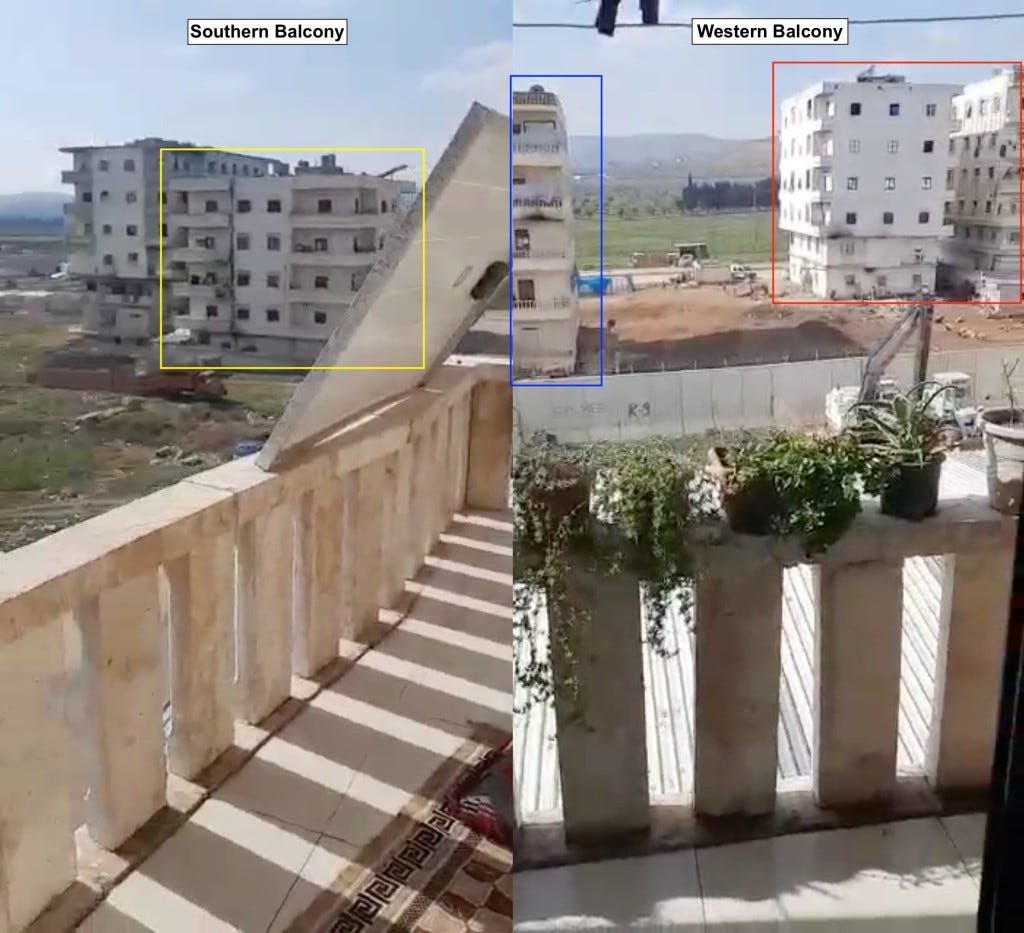What Süleyman Soylu's Eid al-Adha trip tells us about the Turkey's security presence in Afrin
On Tuesday July 20th 2021, Turkey’s Minister of the Interior Süleyman Soylu crossed into Syria, briefly visited the Turkish-occupied cities of Afrin and A‘zaz as part of an Eid al-Adha press tour. Coverage published by various Turkish government social media accounts and state media showed Soylu and his entourage inspecting facilities operated by several government agencies, all subordinates of the Ministry of the Interior and its affiliated General Directorate of Security. While the A‘zaz leg of the trip appears to have been comparatively brief, the Minister of the Interior visited three separate locations across Afrin city, highlighting the intensive, security-driven approach Turkish security agencies employ within Kurdish-populated areas of northern Syria. Given the overall lack of media freedom in Afrin and the role Turkish authorities play in perpetrating abuses against the native population, the small glimpse into the region’s administrative apparatuses represented by coverage of Soylu’s visit offers researchers some valuable information.
Joining Soylu on this trip were an array of figures from the Ministry of the Interior and local provincial governments. Collectively, these men are responsible for overseeing the administration of Afrin (and A‘zaz), for despite the day-to-day activities of the Syrian-staffed local councils, “…in theory…subordinate to the Interim Government…in practice the Turkish Ministry of Interior directly supervises the councils with no real role being played by the Interim Government.” This is facilitated by the Turkish provincial governments adjacent to various parts of Turkish-controlled Syria. For example, “the Turkish province of Hatay directly oversees the councils in the Afrin region through the local Assistant Governor and six of his assistants.” Therefore it makes sense that the Minister of the Interior's entourage included Deputy Minister of the Turkish Interior Ministry Mehmet Ersoy, Hatay Governor Rahmi Doğan, Kilis Governor Recep Soytürk, and Ercan Kayabaşı the District Governor of Kumlu, the location of the Hatay-Afrin border crossing. Additionally, Jandarma General Commander Gen. Arif Çetin and Chief of Police Mehmet Aktaş were present, representing the two bodies publicly responsible for the region’s security, both affiliated with the Ministry of the Interior.

Noticeably absent from Soylu’s itinerary were any stops to positions manned by the Turkish Armed Forces (TSK). These tend to be located along the front lines or in isolated rural areas, a likely indication that the TSK’s deployment is essentially contained to military activity. Additionally, it must be stated that Turkish Intelligence (MIT) is certainly present in some of the locations visited by Soylu and his entourage, though the agency’s role in day-to-day security operations is difficult if not impossible to parse out using openly available materials.

It appears that the first stop on the trip was to the ‘Humanitarian Coordination Center’ (İnsani Yardım Koordinasyon Merkezi), the current title of the former seat of local government, commonly known as the ‘Serail’ or al-Saray al-Hukumi. The Serail is located in the center of the city, in the 'Old Afrin' nieghborhood (36.509801, 36.867146).

Since the city was captured in early 2018, this building and a number of others in its immediate vicinity have been walled off by blast walls, implying the area’s importance with regards to local governance and security.

Initially, an adjacent building housed the headquarters of Afrin’s Turkish-backed ‘Police and General National Security Forces,’ though this was later relocated to a former school to the northwest.
Given the highly visible role Turkish state institutions and affiliated Islamic charities (AFAD, IHH, Beyaz Eller, etc.) play in the region, there seems to be little reason to doubt that the building now operates in this ‘Humanitarian Coordination’ function. Furthermore, one of the men seen at the site during Soylu’s visit is wearing a shirt bearing the logo of the ‘Disaster and Emergency Management Presidency’ (AFAD), affiliated with the Turkish Ministry of the Interior. Images of al-Saray’s façade show a gold plaque likely bearing the building’s official title and affiliation, though the text is unfortunately not legible.

The Minister of the Interior’s convoy soon left for the ‘Security Campus’ (Emniyet Yerleşkesi), located in the al-Fillat (‘Villas’) neighborhood on Afrin’s western edge (36.509435, 36.858294). Beginning in June 2018, Turkey erected blast walls around this site, which now houses a number of the administrative institutions.

These include the Afrin 'Palace of Justice' (36.510059, 36.858774), the General Security Directorate (36.509538, 36.858897), an agency run by the Syrian ‘Police and National General Security Forces’ in conjunction with MIT, and al-Shifa’ Hospital, infamously struck by a deadly rocket barrage last month. Despite some reports to the contrary, it does not appear that any of the SNA factions nor the SNA Military Police are present at the Security Campus, though the local headquarters of the latter is located one block to the south (36.507753, 36.858925).
The fortifications surrounding the Security Campus are not limited to the 1,000 meters of concrete walls demarcating the perimeter. The main entry point, located on the street to the south, consists of two successive security gates.
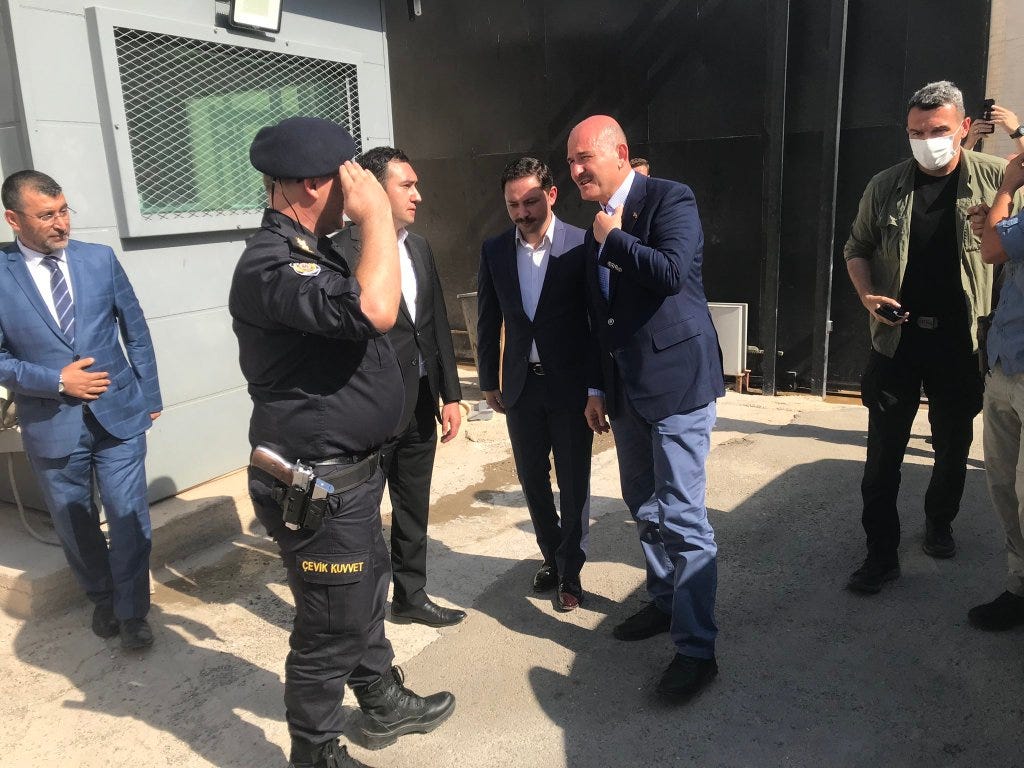
Another gate separates the western half of the Security Campus from al-Shifa' Hospital and the three buildings to its east. At least two watchtowers guard the premises, one by the main entrance and another to the southeast.


Both in coverage of Soylu’s visit and satellite footage taken on May 28th, 2021 included in a recent report regarding the al-Shifa’ Hospital attack published by Syrian Archive, ten American-made Cadillac Gage Commando APCs can be seen parked just west of the compound entrance.


Turkey had purchased at least 124 Cadillac Gage Commando V-150s from the US in the early 1990s, for use by its Police and Jandarma forces. Since 2017, some of these have in turn been transferred to the Turkish-backed Syrian police forces, particularly the A‘zaz branch. It’s unclear which party those seen in Afrin during Soylu's visit belong to.

Outside the Security Campus, the adjacent streets to the north and south feature numerous barricades, limiting access to the public. Given the high degree of security detail present at this location, unmatched elsewhere around the city, it’s clearly of great importance to Turkey’s occupation of the city and region.

Centrally located at the front of the main entrance to the Security Campus lies al-Shifa’ Hospital, the site of Soylu and his entourage’s first stop within the compound. This visit was a continuation of the Turkish State’s media campaign blaming the “YPG/PKK Terror Organization” for the recent attack on the hospital, despite the lack of definitive evidence proving such (further complicated by the overlapping YPG and regime presence in the regions neighboring Afrin to the south and east). Soylu was seen meeting with members of the Syrian American Medical Society (SAMS), the NGO operating in the hospital which lost two of its members in the attack last month. One can observe that the gynecology building, located (36.509676, 36.858537) in between where the two projectiles struck the hospital on June 12th, 2021, has since been demolished.

Subsequently, Soylu inspected two additional sites within the Security Campus, the ‘City Security Management System Building’ (Kent Güvenlik Yönetim Sistemi Binası) and the ‘Governor’s Guesthouse’ (Valilik Misafirhanesi).
Most of the footage appears to show the interior of the ‘City Security Management System Building.’ As indicated by the name, this building appears to bear a central role in local Turkish security efforts. Inside, one can clearly see the emblem of Turkey’s General Directorate of Security (Emniyet Genel Müdürlüğü), the Ministry of the Interior-affiliated body overseeing Turkey’s Police force, hanging on the wall, displayed on a flag and as well as worn on the shirts of at least two individuals.
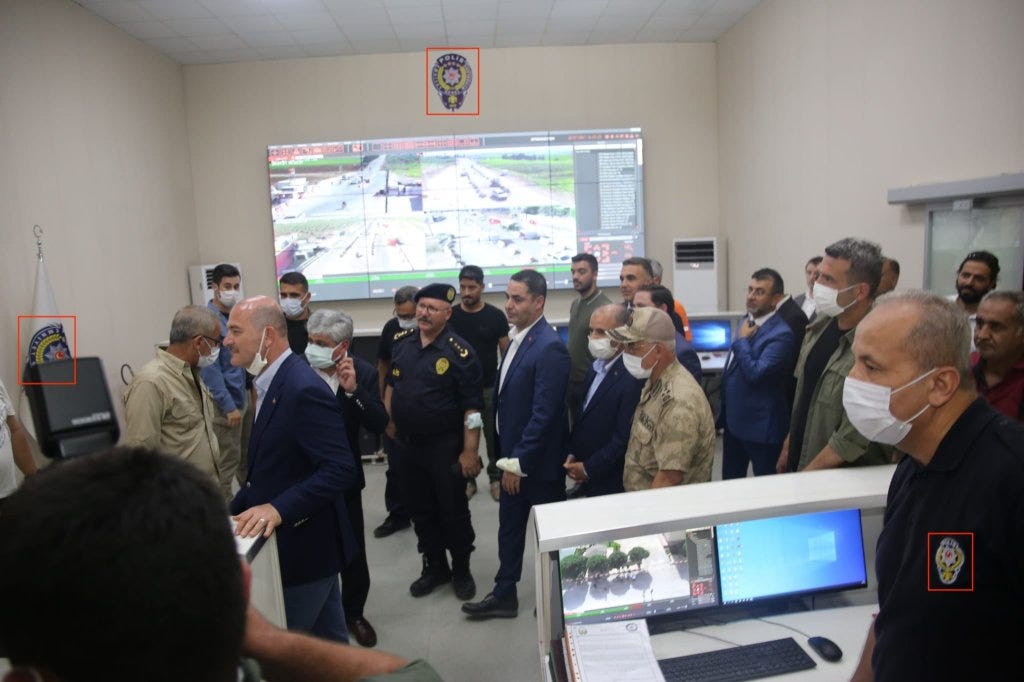
Within this city security building, Soylu is shown in a room in which multiple CCTV feeds are displayed and only Turkish officials appear to be present. The four feeds visible show the primary security checkpoints at the four main entrances to Afrin city.
A map of Afrin city can be seen on the wall, though unfortunately little information can be gleamed from it as resolution is low and multiple individuals obstruct the camera’s view of it. An additional CCTV feed can be seen on one of the desktops. Provided this camera is installed on the City Security Management System Building rather than facing it, geolocation identifies this building as the large one just northwest of al-Shifa’ Hospital.

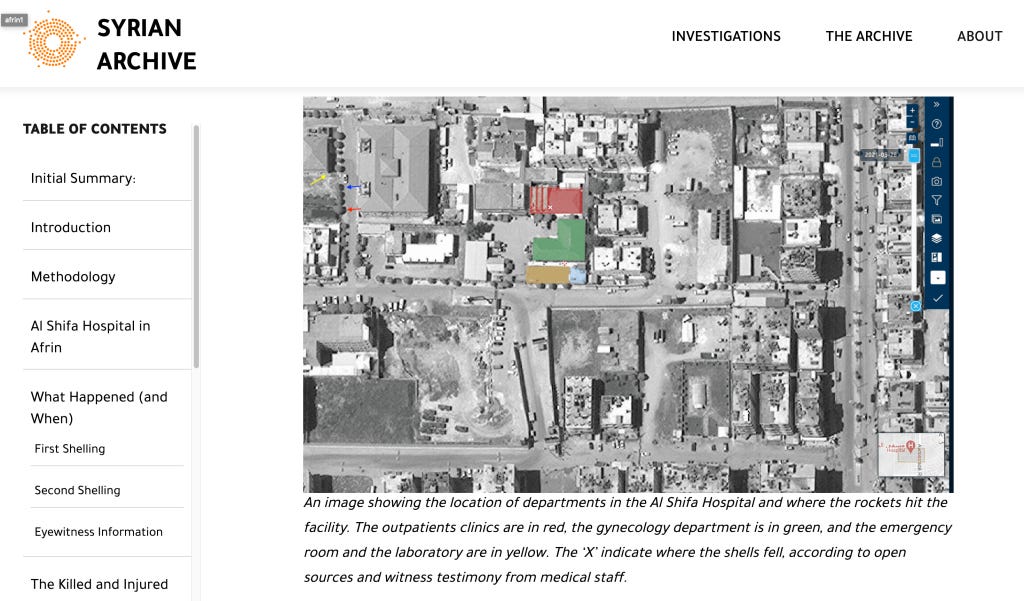
A November 2020 report from Turkish state media outlet TRT Haber highlights a Syrian police ‘Afrin Crime Scene Branch’ (Afrin Olay Yeri Şube) trained by the Turkish General Directorate of Security which operates out of this same building as well.

Soylu’s itinerary next takes him to the “Governor’s Guesthouse,” the name of which implies its purpose is to house the Hatay governor or other Turkish officials while visiting Afrin. The only footage of this building taking during this trip shows a bedroom.

Previous visits by Turkish officials show other amenities, including a dining room with an image of Hagia Sophia painted on the wall.

Media coverage of Minister of Agriculture and Forestry Bekir Pakdemirli’s visit in October 2020 point to this building (constructed in Spring 2020) being located at the northwestern corner of the compound, west of the City Security building.


While footage of Soylu's visit does not show him entering it, at least one other building in the Security Campus appears to be an important part of Turkey's local presence in the area. This is the former Azhar private school, southwest of the city security building. Some reporting has claimed that this school is used as a prison/detention center but scant documentation of this buildings purpose post-2018 makes this allegation hard to confirm or deny. However, it seems quite likely that some buildings within the Security Campus hold prisoners, captured by the Syrian Police or various Turkish security or intelligence branches.

Some coverage of Soylu’s trip as well as video filmed in the aftermath of June 2021’s al-Shifa’ attack offer brief glimpses at the site, the primary entrance of which is accessed through an addition gate west of the hospital. Parts of the former school’s northern side is now covered in caging similar to slate armor used on tanks, assumably intended to protect it projectiles.

The school is further protected by additional blast walls, while the roof now appears to serve as a covered observation post. A massive Turkish flag is draped down the eastern facing wall of the building.
These extensive security precautions point to the former school now being used as a headquarters for one of the Turkish security apparatuses. It's likely not the Turkish Police Special Forces, who maintain a base nearby in Afrin city, but could possibly be a headquarters for the Turkish Jandarma or MIT.
The Minister of the Interior’s last stop in Afrin city was the Turkish Police Special Operations Headquarters (Şehit 4. Sınıf Emniyet Müdürü M. Murat Ertekin Özel Harekat Karargahı), located in the former Faisal Qaddour school.


Like the former Azhar school, this building has recently been covered in the same protective caging.

Previous Turkish state media reporting has highlighted this site as home to the ‘Syrian Task Force,’ made up of Turkish police commandos who both undertake security operations and oversee the ‘Special Operations Units’ drawn from the ranks of the Syrian ‘Police and General National Security Forces.’

Soylu and the Turkish officials accompanying him then ate a meal in the courtyard of the former school, where the Minister of the Interior then gave a speech to the members of the Police Special Forces present. The content of the speech, unsurprisingly given in front of an Ataturk and Erdogan backdrop, consisted of the standard nationalist cliches, which according to Turkish media cause Soylu to tear up.

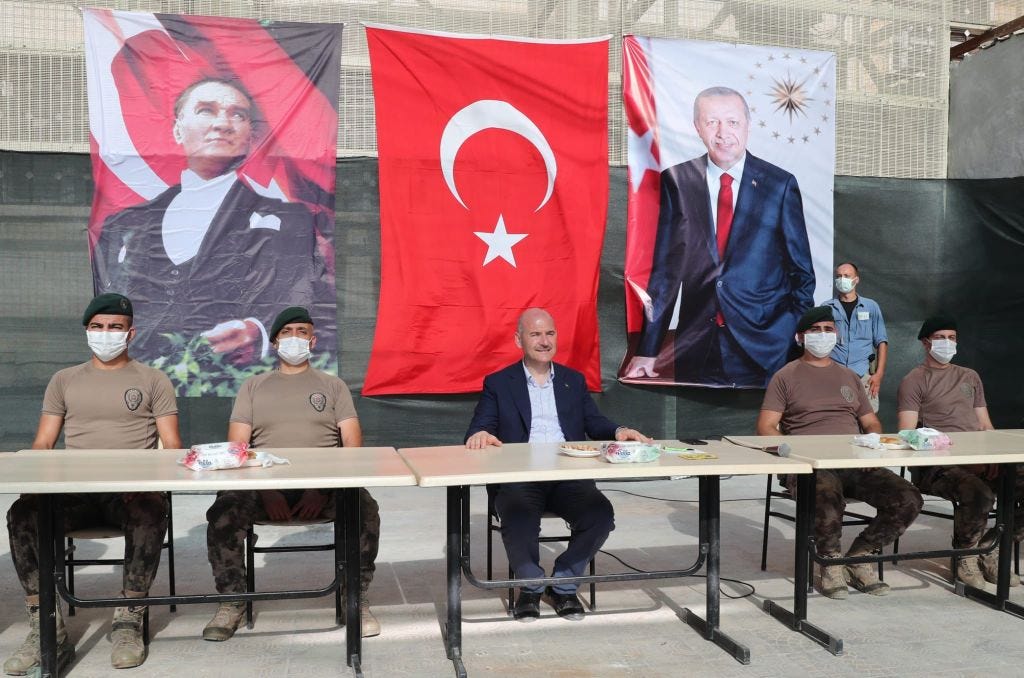

Collectively this visit and the media coverage of it allows for some new insights into how occupied Afrin is run by Turkey. In particular, it is now clear what a central and proactive role is played by the Turkish Ministry of the Interior by way of the General Directorate of Security. Additionally, the information provided allows for further identification of the purposes of the different buildings with the Security Campus, the well-guarded compound in the middle of Afrin city, housing a number of both Turkish and Syrian institutions. Indicative of the dominance of the former over the later is that almost all of the openly available information about this compound comes from Turkish rather than Syrian media.

UPDATE (8/7/21)
I recently came across a video on the 'Madinat Afrin li-Tijarah' Telegram Channel, posted in February 2021, showing the interior of an apartment for rent in Afrin City. The video includes shots of the views from the apartment's western and southern balconies, showing the building to be located within the Security Campus.
Satellite imagery taken from slightly different angles show that this residential highrise does not actually fall within the walled-off compound. The entrance to this building is on the street to the south, representing a gap in the blast walls. As far as we know, this is the only residential building in the immediate area.
UPDATE (11/30/21)
I've identified another individual present throughout Soylu's visit (wearing a dark blue police uniform with a beret) as Hatay Provincial Police Chief and 'Afrin Coordinator Police Chief Nadir Örten, seen in the image below, second from the left.
Special thanks to @hasavrat, @obretix and @mountainguerri1 for their assistance







